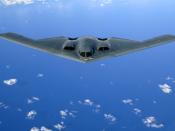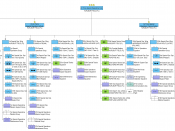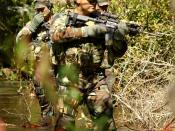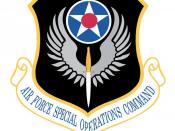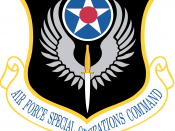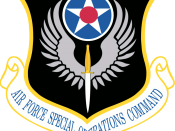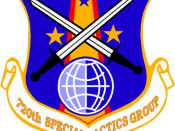The Unknown Air ForceFighter jets, the air show, and Top Gun are all things that make us think of the United States Air Force. These thoughts bring about images of F22s breaking the sound barrier, gigantic C130 bombers ominously flying in enemy skies, and the prestigious Thunderbirds emitting awe striking lines of smoke behind their seemingly impossible mid-air maneuvers. All this and more are part of our nation's one and only Air Force. This branch of the military has become more distinguished every year with its renowned and successful members. Hundreds of thousands of men and women have the honor of saying they have served for the best Air Force in the world.
Formed in 1947 during World War II, as a branch off of the Army, the United States Air Force now employs over 300,000 active members. Its insurmountable fighting power and advances have given it the title of the largest and most technologically superior Air Force in the world.
All who wear the wings patch consider it an honor to serve their country by controlling the blue. And when most of us hear the roar of an afterburner can only fantasize about the thrill of flying quicker than Mach Two miles above the ground. But is the Air Force only about flying? Those 300,000 people cannot all be manning planes. The truth is that the Air Force has sufficient ground forces as well; however, none are more highly trained for combat and survival than the members of the Air Force Special Operations Command.
Like many military organizations, and the Air Force itself, the Air Force Special Operations Command Unit was formed during the high points of World War II. After establishing the Air Force as a new defensive power, many military leaders realized the need for covert combat and rescue teams. Pilots were crash landing or parachuting behind enemy lines, and there was a need for more air stations so that plans could land and restock on supplies or fuel if needed. The first members of AFSOCU (Air Force Special Operations Command Units) did just this and more, which laid the foundations for the three core competencies of Special Tactics according to Steve Scott in a webpage written by Jeff McKaughn: "reconnaissance, terminal control, and recovery" (3). Missions executed under these standards of operations may include, but are not limited to, search and rescue expeditions, infiltration of hostile areas, constructing an airfield in an active warzone, and administering an airstrike behind enemy lines. Procedures like this demand physical and mental strength and stamina as well as courage, valor, and the ability to function in extreme stress. To ready oneself requires years of teaching in many different areas.
The training for a prospect of the AFSOCU is easily one of the most difficult and demanding tasks the Air Force and United States military has to offer. When talking about AFSOC in a magazine article for Popular Mechanics, Scott Gourley states that it takes "more than [eighteen] months of grueling work" (8) to consider yourself a Special Forces member. Tom Vanden Brook says in his writings for USA Today that "the Air Force training is as tough as any military can dish out" (9). Considering these men, "no women are permitted in ST [Special Tactics] units" (Gourley 8), are sent to dozens of specialized schools, such as HALO (High Altitude Low Opening) jumping, survival school, medical training, hand-to-hand combat mastering, and many others, it is no wonder the demands are so strenuous. Brook goes on to tell us that in this instructional phase "the key is the mind-set" because, "it's physically demanding but even more psychologically demanding" (15).
When parachuting from over "thirty-five thousand feet" into "dark rolling seas" one must have their head in the right place (Brook 9). There are plenty of people who can jump out of airplanes and into trembling seas, but it takes a steadfast mindset in order to complete tasks like, occupying a deleterious battle zone, and calling in a precise location to an air-trafficking tower with no errors. In his writings for the Northwest Florida Daily News, Mladen Rudman stresses this fact that it is not just muscles and fire power that get the job done, because AFSOC members must have "the skill to survey a makeshift airstrip behind enemy lines at night and then direct air traffic so U.S. special forces troops can be inserted and resupplied during clandestine operations" (2).
Air Force Special Tactics men's physique and brains must be in optimal conditions, not only for the sake of their own lives, but for the fate of many other military special forces members. As Brook tells us, "often they'll [AFSOC airmen] be embedded with special operations teams from other branches of the military, such as Navy SEALs" (6). SEALs and other groups including Army Rangers are those people hear the most about in media and pop-culture. Most are unaware of the role of the Air Force in covert operations outside of flying jets. All these brave soldiers - AFSOC units, Army Rangers, Green Berets, Navy SEALs, and Marine Force Recon - play pivotal parts of one another's survival.
It is this teamwork that allows Special Forces teams to be regarded as an asset to the United States' involvement in the Middle East. There is little bias between the branches in this area for ample reasons. Divisions this serious in our country's armed forces do not have time for impudent competition or rivalries. The men work together, because if one fails, the group as a whole is at risk. This is shown in training, on the battlefield, and upon mission accomplishment. High ranking officers ensure that this is understood between all and a main focus point for preparation. Another one of Rudman's columns encompasses an interview of four-star Army General Bryan D. Brown. Brown spoke highly of the Air Force in particular when he said, "AFSOC is key to the global war on terror and SOCOM's [United States Special Operations Command] efforts in the global war on terror" (5). Touching on the team effort, he also quoted that "SOFs [Special Operation Forces] bring to the battlefield the unique kind of skills necessary in this type of war" (25).
No matter whom they work with or what work they do, Air Force Special Tactics warriors will undoubtedly be a crucial part of the United States Armed Forces. Their mission, "America's specialized air powerâ¦a step ahead in a changing world, delivering Special Operations power anytime, anywhere" (U.S. Air Force Fact Sheet 1), is a motto that is clearly upheld at all times by this reconnaissance force. They walk the grounds with combat boots, rucksacks, radios, and heavy artillery, but they control the skies using their unfaltering minds and unprecedented knowledge of warfare. For the following reasons and more, these heroes below the speeding jets are an integral element of the United States Air Force.
Works CitedBrook, Tom Vanden. "Special Tactics Training Tests Body, Mind." USA Today 24 May 2006: 6a. Newspaper Source. EBSCOhost. Tarrant County Coll. Lib., Ft. Worth, TX. 3 Apr. 2009 .
Gourley, Scott. "Air Force Special Ops." Popular Mechanics Apr. 2002: n.p. Academic Search Complete. EBSCOhost. Tarrant County Coll. Lib., Ft. Worth. 6 Mar. 2009 .
McKaughan, Jeff. "720th Special Tactics Group Is a Center of Technology Research Benefiting the Warfighter." U.S. Army PEO STRI. 18 Jan. 2008. 13 Apr. 2009 < http://peostri.army.mil/PAO/pressrelease/Specialtactics.jsp >.
Rudman, Mladen. "Special Ops Cadidates Test Their Limits." Northwest Florida Daily News 21 Oct. 2006: n.p. Newspaper Source. EBSCOhost. Tarrant County Coll. Lib., Ft. Worth, TX. 3 Apr. 2009 .
Rudman, Mladen. "Special Ops Chief: Hurlburt Is a 'gem': AFSOC Is Key to the Global War on Terror." Northwest Florida Daily News 28 Jun. 2006: n.p. Newspaper Source. EBSCOhost. Tarrant County Coll. Lib., Ft. Worth, TX. 3 Apr. 2009 .
"U.S. Air Force Fact Sheet: Air Force Special Operations Command." Air Force Link. Sep. 2008. 13 Apr. 2009 < http://www.af.mil/factsheets/factsheet.asp?id=156 >.
